Selected Recipes Of Jacob Swann
These recipes are some favorites of Jacob Swann, the knife-wielding villain from my Lincoln Rhyme novel The Kill Room. Like Hannibal Lecter, Swann finds comfort away from the world of murder and mayhem by practicing his culinary skill. His ingredients, however, come from somewhat lower in the food chain than the good doctor’s.
For the following dishes, Mr. Swann prefers you to use sea salt, like Celtic, Hawaiian or gray. Pepper should be freshly ground. Oil should be extra virgin olive oil. Herbs should be fresh, not dried, and crushed or chopped fine. Regarding stocks, of course it’s best to make your own. But that’s quite time consuming, especially if the police are after you, so an acceptable alternative is to use canned broth in which you’ve simmered bones for several hours: split shank and knuckle bones in the case of beef and veal, and—for chicken—whole carcasses or leg and neck bones. Always strain before using.
The recipes are intended for four persons, unless otherwise noted, even if, in Mr. Swann’s case, not every guest can be counted on to survive to the dessert course.
All Recipes:
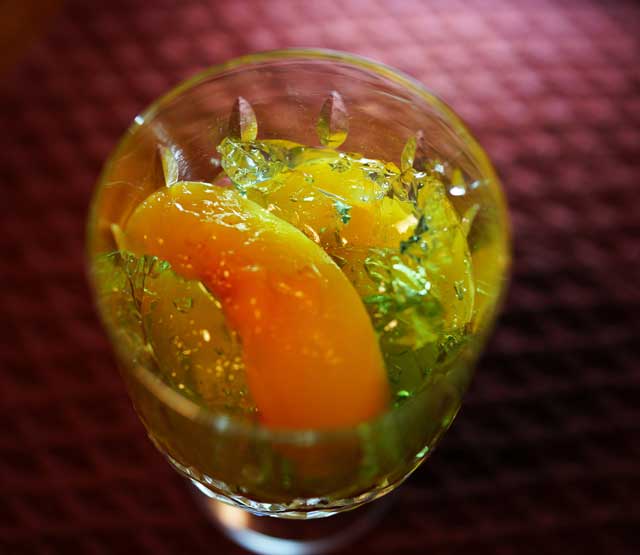
This was one of the deserts served on the first-class menu on the Titanic the night before she sank. The flavor of the liqueur Chartreuse is an acquired one, like aquavit or grappa, but Jacob Swann occasionally enjoys a dish that challenges.
Ingredients:
2 large clingstone peaches, ripe
2 cups granulated sugar
1/4 cup lemon juice
1 cinnamon stick
3 whole cloves
5 teaspoons powdered gelatin, unflavored
1/3 cup white sugar
1 cup Chartreuse
Water as needed
Sprigs of wheat or barley grass for garnish
Directions:
1. Dissolve the gelatin in 1 cup of water. Bring another cup of water to a boil. Lower the heat and add the sugar in the boiled water, stirring until it’s dissolved. Off the heat. Add the Chartreuse and the gelatin mixture and stir to combine. Pour into a glass baking dish that has been lined with plastic wrap. Let the gelatin set completely. This will take between one and two hours.
2. Combine 2 cups water and the sugar in a saucepan; cook over medium heat, stirring constantly until sugar is dissolved. Bring to a boil and cook until syrup is clear, about a minute or two. Add lemon juice, cinnamon stick and cloves.
3. Peel and slice the peaches and add to the syrup pan. Poach until tender, about 5-6 minutes. Off the heat and let them cool, remaining in the liquid.
4. Lift the wrap holding the gelatin out of the baking pan and cut into small squares.
5. To serve, place peach slices in a large martini glass, cover with gelatin cubes and garnish with sprigs of the edible grass.
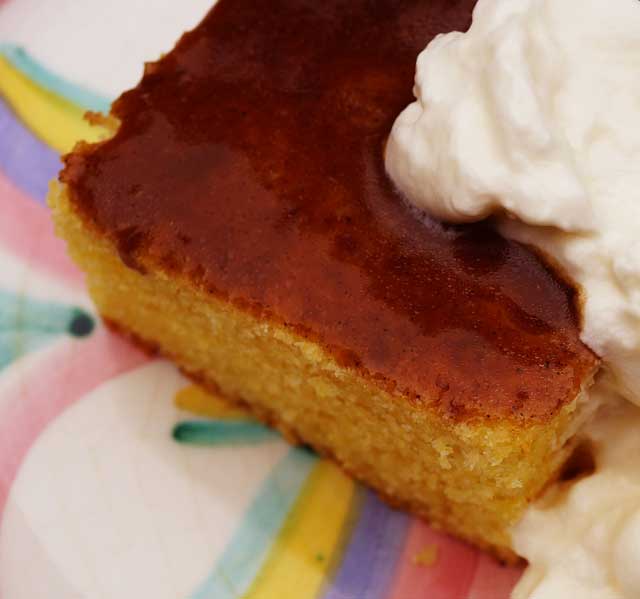
Jacob Swann got this recipe from, of all people, my grandmother, an even better cook than he.
Ingredients, cake:
2 eggs
1 tablespoon butter
1/2 cup milk
1 cup flour
1 teaspoon vanilla
1 cup sugar
1 teaspoon baking powder
1/2 teaspoon salt
Ingredients, icing:
5 tablespoons brown sugar
3 tablespoons unsalted butter
2 tablespoons heavy cream
Directions:
1. Preheat oven to 350 degrees F.
2. Beat eggs until thick and lemon-colored, four minutes. Don’t cheat; beat.
3. Add sugar and vanilla. Continue beating for another four minutes. Don’t forget the part about not cheating.
4. Sift together flour and baking powder, salt. Add to sugar-butter-egg mixture slowly, beat on low mixer.
5. Scald the milk and add butter. Cool to the point where it’s touchable.
6. Mix together milk-butter and flour-egg.
7. Pour in greased and floured 9-inch pan.
8. Bake until a toothpick inserted into the cake comes clean, so to speak, about 25 minutes.
9. Heat icing ingredients over low to medium heat until thick. Spread on warm cake. Place cake under broiler until bubbling, watching like a cliché’d hawk, to make sure it doesn’t burn.
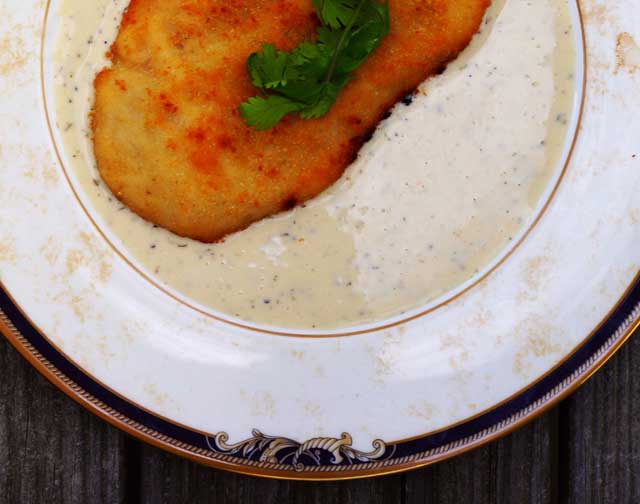
Ingredients:
4 boneless, skinned chicken breasts, with the tenderloins removed
2 cups unseasoned panko crumbs
½ cup grated parmesan cheese
3 eggs
½ cup all-purpose flour
2 garlic cloves, finely minced
Olive oil as needed
Butter as needed
2 cups heavy cream
1 tablespoon Dijon mustard
1/4 cup fresh lemon juice
1/4 cup chicken stock
Nutmeg
Water
Pepper
Salt
Fresh dill sprigs for garnish
Directions:
1. Heat oven to warming.
2. Place chicken between sheets of wax paper and pound to ¼-inch thickness (use the non-murder-weapon hammer or hatchet).
3. In a mixing bowl combine flour, nutmeg, salt and pepper. In second bowl whisk eggs. In another bowl, combine breadcrumbs and cheese.
4. Heat about 2 tablespoons each oil and butter over medium heat in a skillet.
5. Dredge chicken in flour, then coat in egg mixture and finally in the bread crumbs. Make sure there’s no naked chicken; use your fingers (this gets rather gluey; Mr. Swann wears gloves).
6. Sauté the chicken in the pan for about three minutes on each side, until they middle is no longer pink and outside is crispy and brown. Don’t overcook it (dry chicken is a travesty). Remember: Small batches!
7. Remove sautéed chicken from pan and warm in oven.
8. Add more oil-butter mixture and cook the garlic until golden. Remember: garlic burns to cinders faster than the careers of most reality show contestants. Be vigilant.
9. Add cream, up the heat and boil while whisking until reduced by one-half and thickened.
10. Lower heat. Add mustard, lemon juice and chicken stock. Simmer for three or four minutes, then adjust seasonings.
11. Pour sauce on a serving platter, place chicken atop the sauce and garnish with dill sprigs.
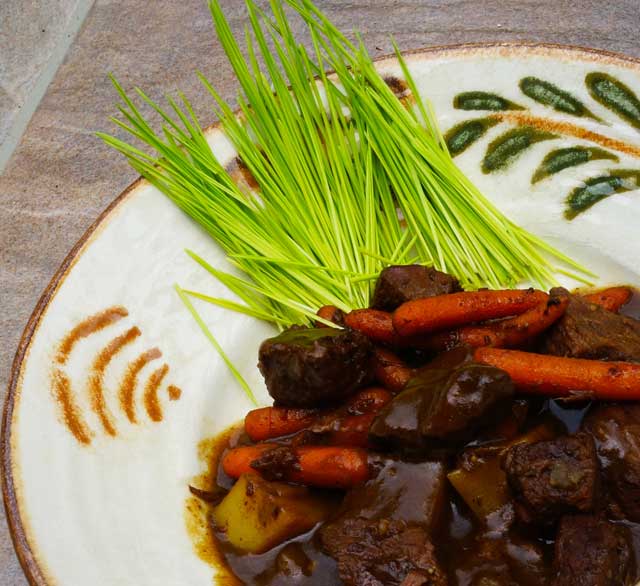
This serves six to eight—but Mr. Swann would recommend being antisocial and inviting only four people to dinner. Because the dish is even better the next day, save a good portion for yourself.
Remember to start the recipe the night before. You’ll see why below.
And by the way, the word “venison” technically refers to any game, not just deer (it’s from the Latin for “hunting”). It’s fun to drop this factoid at a dinner party, though probably not one at which vegans are present.
Ingredients:
3 tablespoons olive oil
1 quart of buttermilk
3 pounds venison loin, with fat and silverskin removed, cut into 1 ½ inch cubes
3 large yellow onions, chopped
2 cups baby carrots
2 large Idaho potatoes, peeled and cut in 1 ½ inch cubes
2 tablespoons minced garlic
3 bottles of stout, like Guinness (12-ounce bottles)
5 cups beef stock
3 tablespoons dark brown sugar
1 teaspoon Worcestershire sauce
2 bay leaves
2 tablespoons fresh thyme, chopped fine
Olive oil
Cayenne pepper
Salt
Pepper
Butter as needed
All-purpose flour as needed
Directions:
1. The night before serving, pierce the cubes of venison with a fork, place in a glass bowl and add the buttermilk, cover with plastic wrap. Soak until you’re ready to start cooking the next day. This removes some of the gaminess of the venison.
2. When ready to cook, remove the venison and discard the buttermilk. Pat dry the meat, season with salt and pepper.
3. Heat the oil to sizzling in a Dutch oven.
4. Dredge the venison in flour then sear on all sides for several minutes until brown. (Small batches again!) Remove the meat and set aside.
5. Reduce the heat to medium and sauté the onions, stirring constantly. Cook until they’re translucent, about ten minutes.
6. Add the garlic, cook until golden, about 3-5 minutes.
7. Pour in the Guinness and the beef stock. Add the bay leaf, brown sugar, cayenne and Worcestershire sauce
8. Up the heat, bring to a boil. Lower heat to simmer.
9. Add the meat and simmer, covered, for two hours.
10. Add the carrots and potatoes and continue simmering for another 45 minutes, or until the vegetables are fork tender.
11. If the sauce is too thin, make some butter manié—lazy-man’s thickening agent. Mix 3 tablespoons room-temperature butter and 3 tablespoons flour together in a bowl to make a smooth paste. Ladle a cup or so of the stock into the bowl slowly and whisk together. Then slowly add ½ of the resulting liquid back to the stew pot, stirring and letting the manié cook. If the stew sauce is still too thin, repeat.
12. Serve in bowls, with plenty of crusty French bread and butter (Mr. Swann does not approve of margarine).
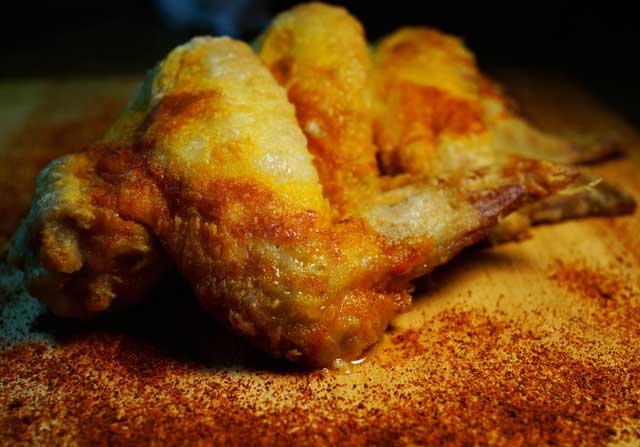
I know I said the recipes serve four. This one could serve four as an appetizer, or it could serve one: me, for instance, I’m home alone with a nice salad, a cold Chimay beer and a new episode of Veep or House of Cards or a John Gilstrap novel to enjoy.
Ingredients:
1 clove of garlic, crushed
¾ cup dry white wine
½ teaspoon Worcestershire sauce
1 cup all-purpose flour
½ teaspoon cayenne pepper
½ teaspoon salt
¾ teaspoon ground black pepper
25 chicken wings
¾ cup melted butter—salted or unsalted; your call
½ cup hot sauce of your choosing
Directions:
1. Combine marinade in plastic bag and add wings. Refrigerate overnight.
2. Remove wings from marinade (discard marinade) and pat wings dry. Place wings, flour, cayenne pepper, salt and black pepper in plastic bag. Shake to thoroughly mix.
3. Place the wings on oiled baking sheet. Refrigerate for one hour.
4. Preheat oven to 400 degrees F.
5. Combine melted butter and hot sauce in a small bowl, whisk. Brush generously on wings, top and bottom.
6. Bake for twenty minutes, turn wings over and bake for another 20-30 minutes until done (internal temperature of 180 degrees F).
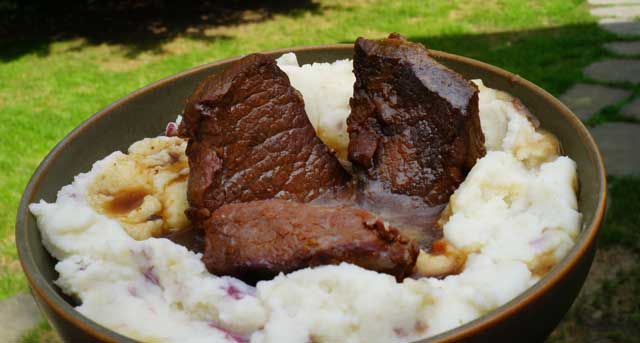
Ingredients:
4 pounds beef short ribs, cut crosswise into 2″-3″ pieces
3 tablespoons olive oil
2 medium onions, chopped
2 tablespoons all-purpose flour
1 tablespoon tomato paste
2 ¼ cups dry red wine
1 teaspoon each crushed thyme, rosemary, oregano and sage
1 bay leaf
2 cloves of garlic, crushed
3 cups beef stock
Salt and pepper
Sprigs of some herb for garnish. You pick. Mr. Swann can’t do all the work.
Directions:
1. Preheat oven to 350 degrees.
2. Salt and pepper ribs.
3. Heat oil in a Dutch oven and brown ribs slowly in batches so that they’re thoroughly browned. Set ribs aside.
4. Drain off most of the oil and drippings, leaving about 3 tablespoons in the Dutch oven.
5. Brown onions. Add flour and tomato paste and cook this mixture, while stirring constantly for several minutes until uniform in texture.
6. Return ribs (and any juice from plate) to the Dutch oven. Add wine. Bring to a boil then lower the heat to simmer.
7. When liquid is reduced to about half, add the herbs and garlic.
8. Add stock and bring to boil, then cover and transfer to the oven.
9. Bake until ribs are very tender, about 2 ½ hours.
10. Transfer to serving platter. Add garnish. Skim fat from the liquid and boil to thicken on stove top, then strain into serving bowl.
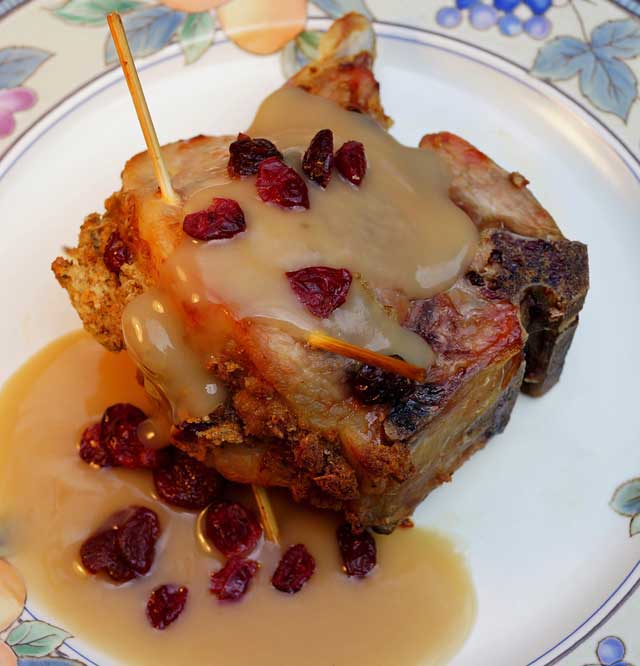
Ingredients:
2 tablespoons olive oil
4 thick pork chops, with bone in
3 cups French bread, cubed and toasted
½ stick of unsalted butter
¼ cup chicken stock
4 tablespoons chopped dried cherries
4 tablespoons chopped raisins
¼ teaspoon each, sage and rosemary, crushed
2 tablespoons finely chopped onion
Pinch of salt and pepper
1/3 cup kirsch
Additional melted butter
Additional chicken stock
Whole dried cherries and raisins for garnish
Directions:
1. Preheat oven to 350 degrees F.
2. Slice slits into the pork chops to the bone.
3. In a sauce pan, heat butter over low to medium heat (it burns easily!) and slowly cook the onions, cherries and raisins until soft.
4. Off the heat. Add to the pan the bread cubes, chicken broth, spices and salt and pepper, and mix.
5. Stuff mixture into the slits in the pork chops, secure with toothpicks.
6. In an ovenproof cast-iron skillet, heat the oil and brown the pork chops.
7. Add to baking dish and brush with additional butter.
8. Bake uncovered for 30-40 minutes until done (internal temperature 160 degrees F).
9. Remove chops to serving plate.
10. Deglaze skillet over low heat with kirsch (careful, it can catch fire!) and chicken stock. Pour over the chops, garnish with additional cherries and raisins.
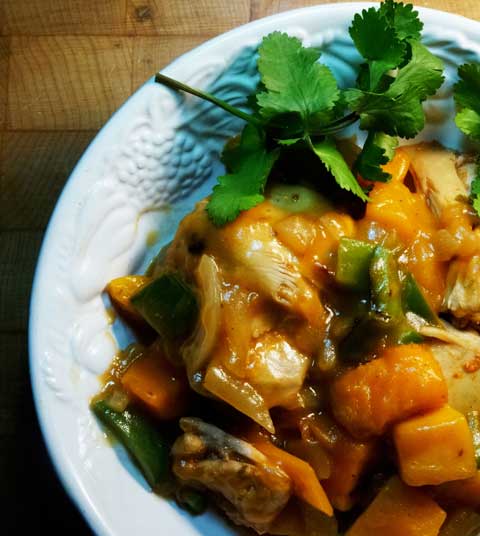
Ingredients:
1 cup all-purpose flour
1 tablespoon cumin powder
3 tablespoons crushed sage
2 pounds boneless, skinless chicken thighs
Olive oil as needed
1 cup Vidalia or sweet onion, diced
1 cup green pepper, diced
2 cups sweet potatoes or yams, cut in 1 inch cubes.
2 tablespoons fresh Cilantro, chopped
Cholula hot sauce
15-ounce can of coconut milk, opened (Ha—just seeing if you’re awake)
2 cups chicken stock
2 tablespoons cornstarch, dissolved in 2 tablespoons light rum (it should be cold)
Salt
Pepper
Directions:
1. Combine the flour, cumin powder, sage, salt and pepper in a bowl.
2. Dredge chicken in flour mixture.
3. Heat about 2 tablespoons oil in a large Dutch oven. Add chicken thighs two or three at a time and brown thoroughly—about ten minutes per side. Remove chicken.
4. Add more oil and sauté the onion and bell pepper until tender.
5. Return chicken to pan, add coconut milk, chicken stock and sweet potatoes. Add hot sauce, salt and pepper to taste.
6. Cook covered for 35-45 minutes, until the chicken and sweet potatoes are fork tender.
7. To thicken sauce, if necessary, add 1 tablespoon of the corn starch-rum mixture and cook, stirring constantly. Repeat if necessary.
There are three required accompaniments for this dish: Rice, rice and rice.
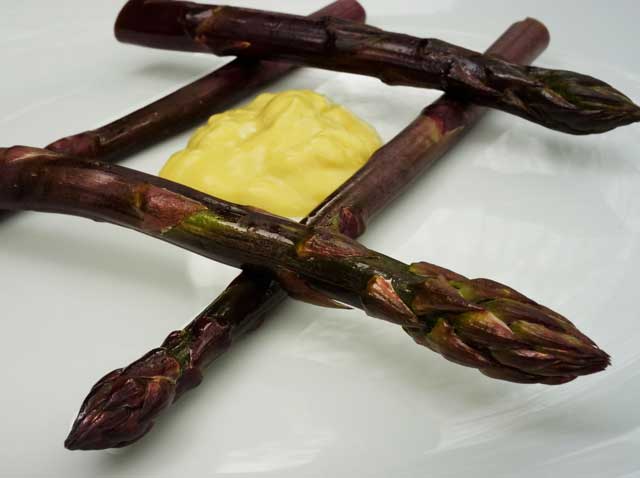
The purple variety of asparagus is sweeter and more tender than green or white. You don’t need to trim much of the base, perhaps just ¼ inch or so. Make the sauce first because the asparagus should cook very quickly.
Ingredients:
16 stalks purple asparagus
½ cup white vermouth
4 egg yolks
1 tablespoon freshly squeezed lemon juice
1 stick unsalted butter, melted
Cayenne pepper
Salt
Instructions for Hollandaise:
1. Whisk egg yolks and lemon juice together in the top pan of a double boiler or a stainless steel bowl and until the mixture is thickened and roughly double the volume.
2. Place the pan on the double boiler or, if using the stainless bowl, atop a saucepan smaller, containing water, smaller than the bowl; the water should not touch the pan; it’s the steam that does the cooking.
3. Turn heat to low and whisk rapidly as the eggs cook. If they get too hot, they’re scramble and while that would make a good snack, you’d have to start all over again. So, remember: low heat, constant whisking.
4. Slowly drizzle in the butter and continue whisking until the sauce is thickened and doubled in volume. Remove from heat, add a pinch of cayenne and pinch of salt.
Instructions for Asparagus
1. Add the vermouth and water in the bottom of a vegetable steamer.
2. Bring the liquid to a boil.
3. Add the asparagus.
4. Steam for 3-5 minutes until cooked but still crispy.
5. Place on serving platter, sprinkle with salt and pepper and add a small amount of hollandaise .
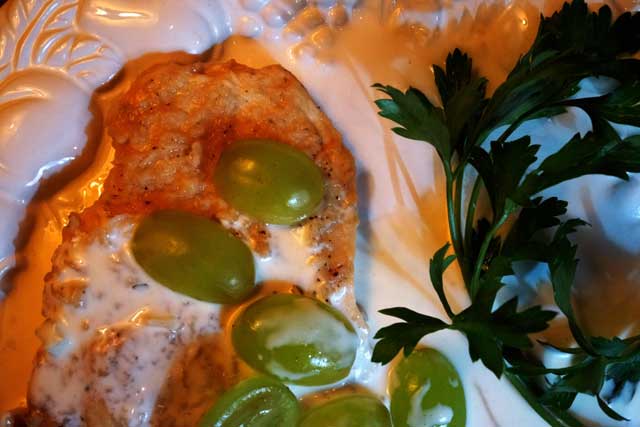
Ingredients:
4 veal cutlets
1 cup all-purpose flour
Butter as needed
Olive oil as needed
2 tablespoons shallots, sliced thin
1 clove of garlic, minced
12 ounces beef or veal stock
1/2 cup sherry
1/2 cup heavy cream
8 ounces white seedless grapes
4 sprigs fresh parsley
Salt
Pepper
Directions:
1. Dredge the cutlets in the flour then season with salt and pepper. Sauté in two tablespoons each of butter and oil. Cook until crispy, just a few minutes. Remember the small-batch rule. Set aside in a warming oven.
2. In the same pan in which you’ve sautéed the cutlets, combine one tablespoon each of butter and oil and cook, over low heat, the shallots and garlic until translucent. Add the stock and sherry and bring to a boil, scraping the pan. Reduce the liquid by half.
3. Whisk in the cream and bring to boil again. Lower heat and cook until thick.
4. Cut the grapes in half and in a separate sauté pan cook them in over medium heat in one tablespoon each butter and oil until soft.
5. Place cutlets on plate, top with grapes and pour sauce over the top. Garnish with the parsley.
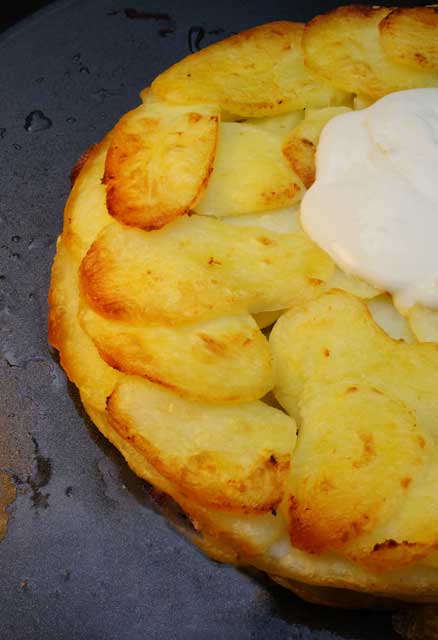
This dish actually does have historical French roots. It dates to Napoleon III’s era and was created by Adolphe Dugléré, at one time the chef de cuisine for the Rothschild family and later the owner of the famous Café Anglais in Paris. No one is quite sure which Anna the dish was named after, but Jacob Swann’s money is on the 19th-century Parisian courtesan Anna Deslions because if you’ve seen her picture, as he has, you’d vote for her too.
M. Dugléré might not approve of Jacob Swann’s finishing addition, but it enhances the flavors quite well. And, of course, it’s a very risky idea to criticize Mr. Swann.
Ingredients:
6 tablespoons unsalted butter
2 pounds russet potatoes, peeled and sliced as thinly as you can (go for 1/8 inch)
Salt
Pepper
Allspice
¾ cup crème fraîche
2 tablespoons maple syrup
Directions:
1. Preheat oven to 350 degrees F.
2. Pat dry the potatoes.
3. Melt butter in saucepan.
4. Generously brush a 10-inch cast-iron skillet with butter from the top layers of the saucepan, avoiding the butter solids.
5. Cover the bottom of the skillet with an overlapping layer of potato slices.
6. Brush this layer with more butter. Sprinkle with salt, pepper and a small pinch of allspice. Build another layer of potatoes and sprinkle with the seasonings. Repeat until you’ve used all the potatoes. Pour any remaining butter-oil on the top.
7. Cook over low heat until potatoes are golden on the bottom and crisp around the outside, about 20 to 25 minutes. Shake occasionally to keep the potatoes from sticking or dislodge with a spatula.
8. Place a plate or lid over the potatoes and carefully invert, so that they drop from the skillet.
9. Brush skillet with more butter and slid the potatoes, now inverted, back into it.
10. Bake until crisp, about 20-25 minutes.
11. Whisk together the crème fraîche and maple syrup in a small bowl.
12. When they’re done, slide the potatoes onto a cutting board and slice into wedges. Place on each guest’s plate and, just before serving, add a dollop of the crème fraîche, whatever a dollop is.
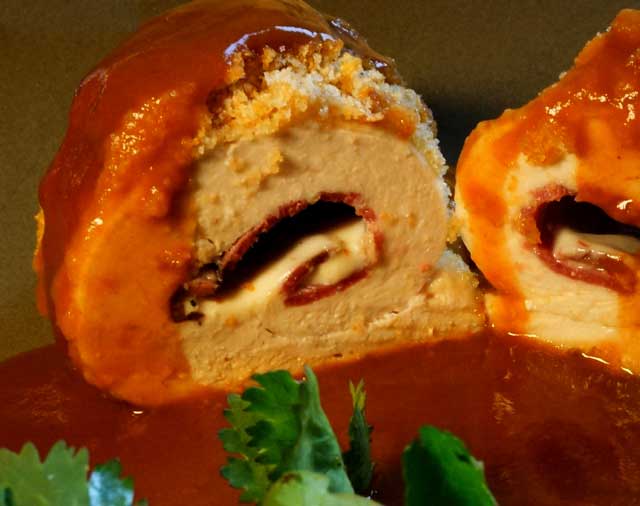
The elegant name (meaning “blue ribbon”) suggests a dish that might have been served to Charles d’Albret, leader of the French army, the night before his defeat by Henry V at Agincourt in 1415. Nor is it unreasonable to speculate that this was Marie Antoinette’s last meal. However, the truth: chicken cordon bleu is an American creation from the flower-child era, first appearing in the late 1960s. Far out.
It’s traditionally served with a white wine cream or a cheese sauce. Mr. Swann likes it simpler, however, moistened only with a little demi-glaze. He’s okay with your making that from a prepared mix.
Ingredients:
4 boneless, skinned chicken breasts, with the tenderloins removed
4 slices of thinly sliced black forest ham, a little smaller than the size of the chicken breasts when pounded flat
4 thin slices Emmenthal cheese, ditto the size
½ cup all-purpose flour
1 teaspoon paprika
Butter as needed
Oil as needed
Salt
Pepper
1 cup chicken demi-glaze made from a prepared package like that sold by More Than Gourmet
Sprigs of fresh cilantro
Directions:
1. Preheat oven to 350 degrees F.
2. Place chicken between sheets of wax paper and pound to ¼-inch thickness (Mr. Swann uses the side of a hammer or hatchet—one reserved exclusively for cooking, by the way).
3. Place a slice of ham on the chicken and then a slice of cheese over the ham. Roll up the chicken breast with the cheese and ham on the inside and secure with toothpicks. Get as tight a seal as you can—escaping cheese is a sign of careless preparation.
4. Mix the flour, paprika, salt and pepper in a small bowl. Coat the chicken breasts on all sides with the resulting mixture.
5. Heat about three tablespoons each of oil and butter in a skillet over medium high heat. If the pan isn’t large enough for all four breasts, work in batches. (Remember this for all of Mr. Swann’s recipes involving sautéing; the small batch rule is quite important in his culinary world, lest you end up steaming. Very bad.) Cook the breasts until browned on all sides.
6. Place the browned chicken in a buttered baking disk.
7. Bake for about 10 minutes, until the flesh of the chicken is no longer pink—but don’t overcook. The rule is 165 degrees F, tops, for the internal temperature.
8. While the dish is baking, prepare demi-glaze according to instructions.
9. Place on serving platter, remove toothpicks, especially if you have litigious guests, and drizzle on a bit of demi-glaze. Garnish with cilantro. Serve with whatever else you want. It’s your dinner party, after all.
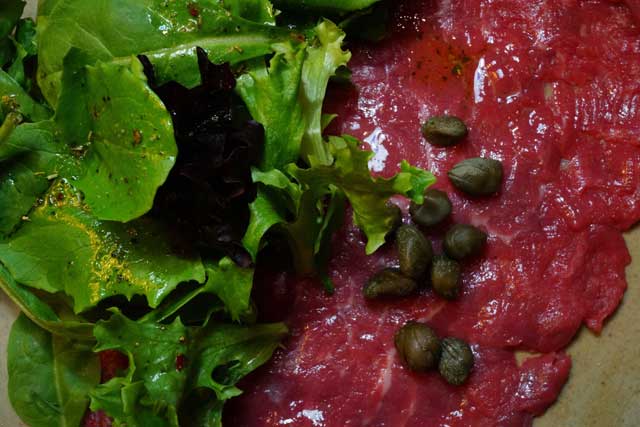
Ingredients:
Four pieces New York Strip steak, four ounces each, trimmed of side fat, pounded so thin you can nearly read through it
1 cup olive oil
2 tablespoons balsamic vinegar (use the stuff from Modena, but there’s no need to buy at the Ferrari level; a $15 bottle will do nicely)
1/4 cup Calvados apple brandy
1 teaspoon thyme
Juice of one lemon
2 garlic cloves, minced
1 tablespoon capers
2 cups mixed salad greens
1 cup arugula
Salt
Pepper
Directions:
1. Combine oil, vinegar, Calvados, salt, pepper, thyme, lemon juice and garlic in a glass bowl. Whisk energetically to mix. Pour into large, flat baking dish.
2. Add beef to the dish and smush it around to coat. Cover with plastic wrap. Marinate for 5 hours, turning occasionally.
3. To serve, set one portion of beef on a serving plate and cover half of the slice with some of the greens and arugula and the dot the other half with capers. Strain the marinade and pour a small amount of the strained liquid on the salad.
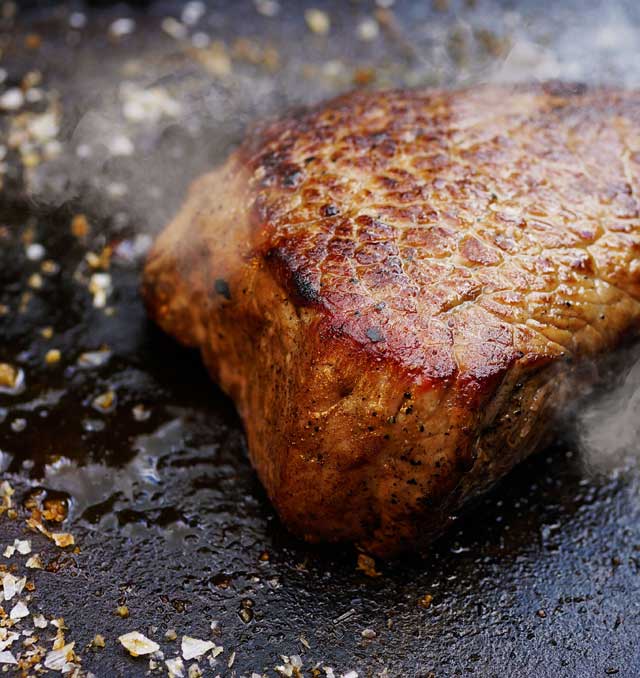
Mr. Swann was inspired by the famous James Beard in creating this recipe.
Ingredients:
Four six-ounce filet mignons, two inches thick
Oil as needed
Butter
1/2 cup beef stock
Dry red wine like cabernet, chianti or Barbaresco
Salt
Pepper
Italian parsley
Directions:
1. Sprinkle the salt into a cast-iron skillet, place the skillet over high heat for five minutes. Go for it. We’re talking red hot if your range is up to the task. (N.B.: you might want to disable smoke detectors temporarily.)
2. Cook the filets one at a time. Holding a filet with tongs, sear all four edges. Remove and sprinkle more salt onto the pan. Place the filet flat side down in the pan until seared then turn over and sear the other side, until the desired level of doneness is reached. The maximum temperatures in each range are 125-degrees F for rare, 135 for medium rare, 145 for medium, 155 for medium well, 160 and up for well done. (Opinionated about food otherwise, Mr. Swann is not a snob when it comes to cooking meat. If you enjoy it blue or enjoy it burnt, that’s what’s important. A favorite Latin expression of his: De gustibus non est disputandum).
3. Remove filet to serving platter. Repeat with each filet.
4. Lower the heat and deglaze the pan with wine, beef stock. Up the heat until the liquid is reduced. Add one tablespoon of butter. Pour jus over the filets. Garnish platter with parsley.
*all photos by Jeffery Deaver

